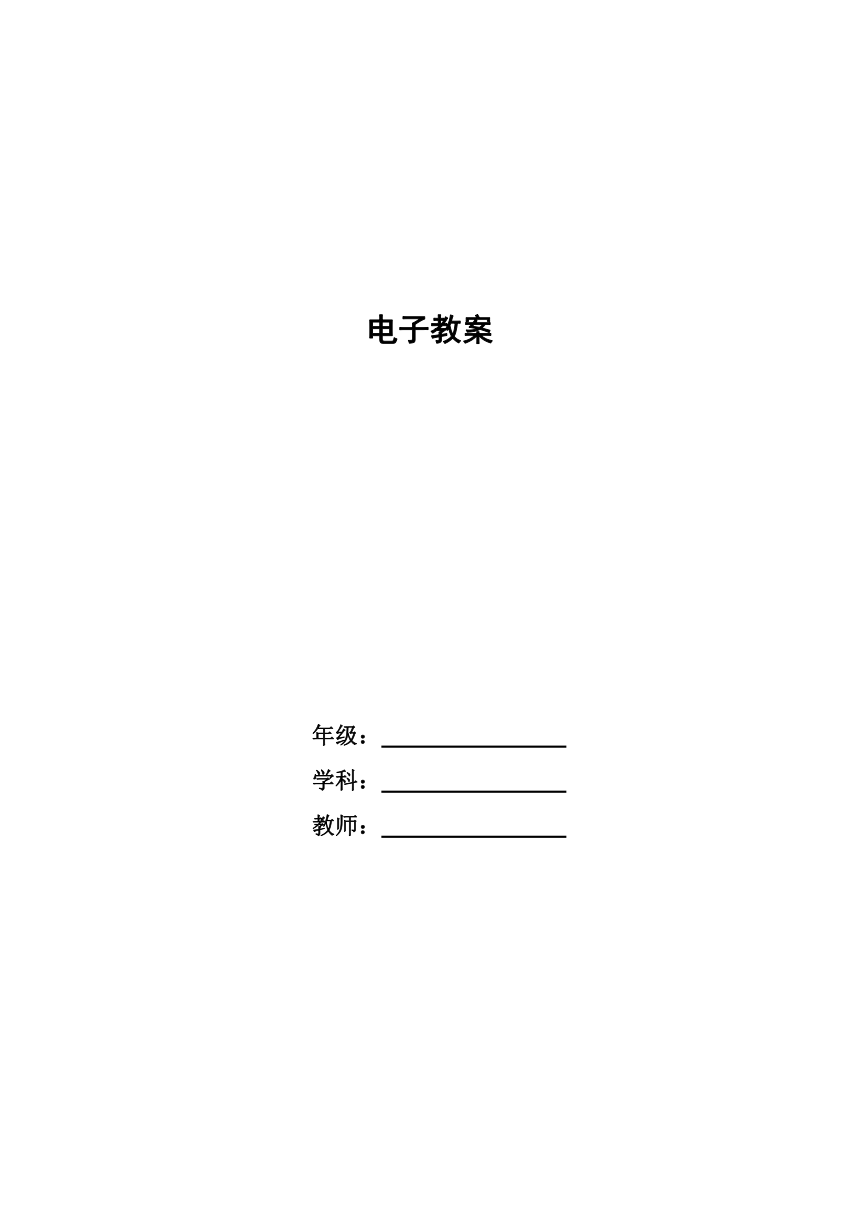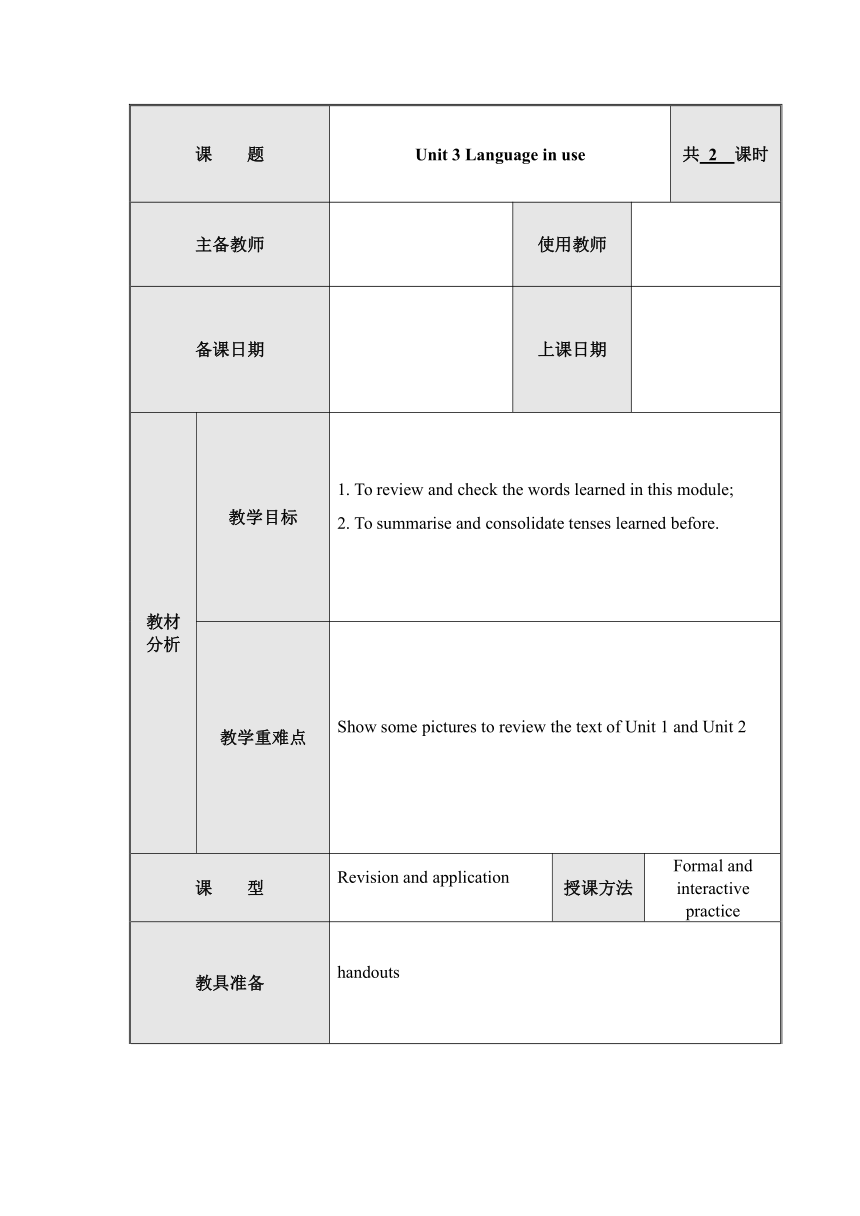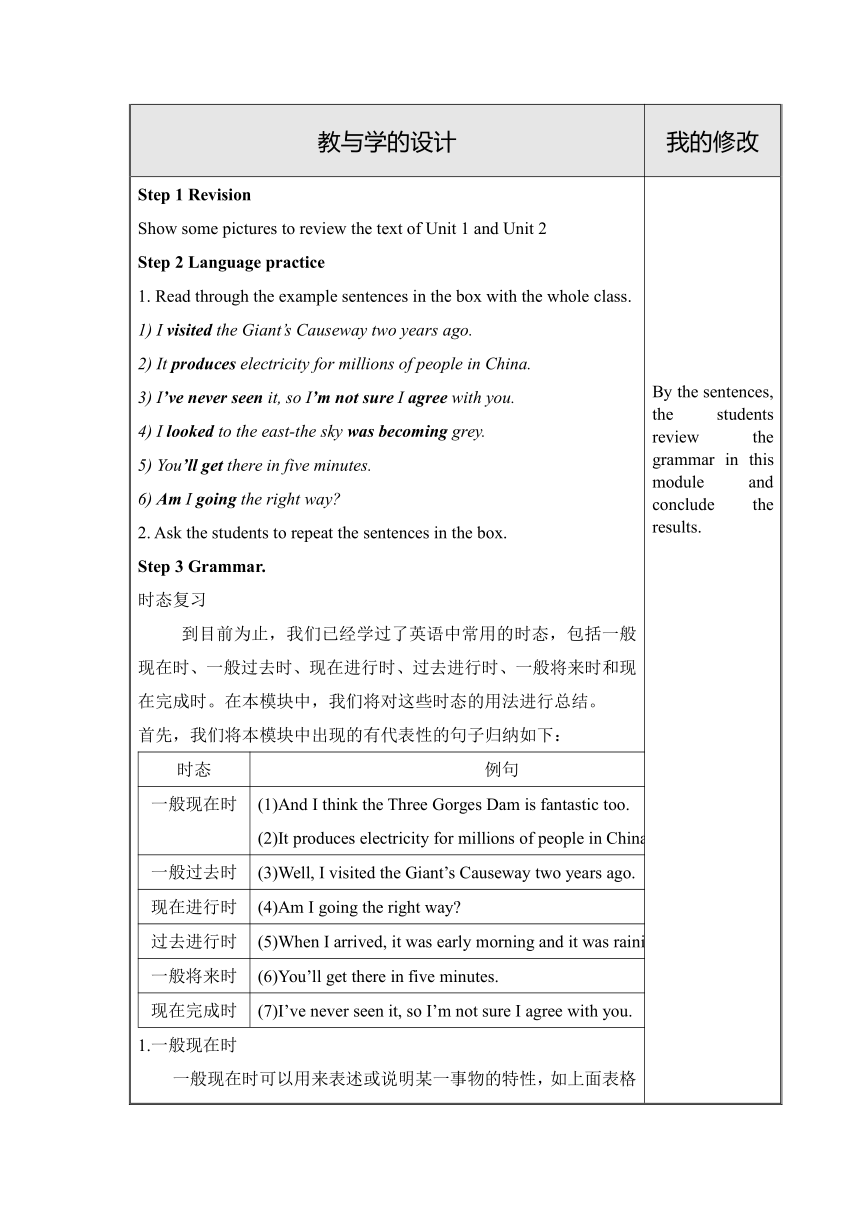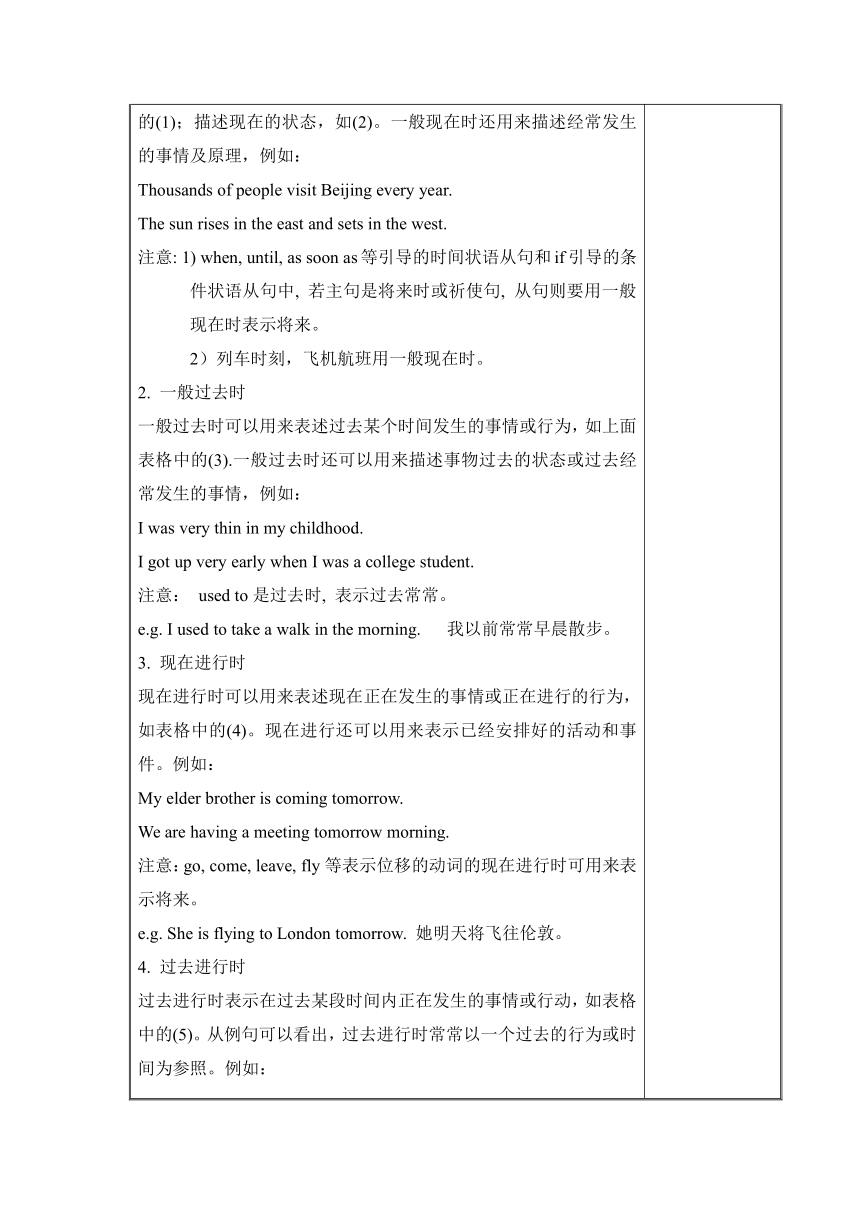Module 1 Wonders of the worldUnit 3 Language in use(1)教案
文档属性
| 名称 | Module 1 Wonders of the worldUnit 3 Language in use(1)教案 |  | |
| 格式 | zip | ||
| 文件大小 | 16.0KB | ||
| 资源类型 | 教案 | ||
| 版本资源 | 外研版 | ||
| 科目 | 英语 | ||
| 更新时间 | 2015-09-15 08:47:05 | ||
图片预览




文档简介
PAGE
电子教案
年级:
学科:
教师:
课 题 Unit 3 Language in use 共 2 课时
主备教师 使用教师
备课日期 上课日期
教材分析 教学目标 1. To review and check the words learned in this module;2. To summarise and consolidate tenses learned before.
教学重难点 Show some pictures to review the text of Unit 1 and Unit 2
课 型 Revision and application 授课方法 Formal and interactive practice
教具准备 handouts
教与学的设计 我的修改
Step 1 RevisionShow some pictures to review the text of Unit 1 and Unit 2 Step 2 Language practice1. Read through the example sentences in the box with the whole class.1) I visited the Giant’s Causeway two years ago.2) It produces electricity for millions of people in China.3) I’ve never seen it, so I’m not sure I agree with you.4) I looked to the east-the sky was becoming grey.5) You’ll get there in five minutes.6) Am I going the right way 2. Ask the students to repeat the sentences in the box.Step 3 Grammar.时态复习到目前为止,我们已经学过了英语中常用的时态,包括一般现在时、一般过去时、现在进行时、过去进行时、一般将来时和现在完成时。在本模块中,我们将对这些时态的用法进行总结。首先,我们将本模块中出现的有代表性的句子归纳如下:时态例句一般现在时(1)And I think the Three Gorges Dam is fantastic too.(2)It produces electricity for millions of people in China.一般过去时(3)Well, I visited the Giant’s Causeway two years ago.现在进行时(4)Am I going the right way 过去进行时(5)When I arrived, it was early morning and it was raining.一般将来时(6)You’ll get there in five minutes.现在完成时(7)I’ve never seen it, so I’m not sure I agree with you.1.一般现在时一般现在时可以用来表述或说明某一事物的特性,如上面表格的(1);描述现在的状态,如(2)。一般现在时还用来描述经常发生的事情及原理,例如:Thousands of people visit Beijing every year.The sun rises in the east and sets in the west.注意: 1) when, until, as soon as等引导的时间状语从句和if引导的条件状语从句中, 若主句是将来时或祈使句, 从句则要用一般现在时表示将来。2)列车时刻,飞机航班用一般现在时。2. 一般过去时一般过去时可以用来表述过去某个时间发生的事情或行为,如上面表格中的(3).一般过去时还可以用来描述事物过去的状态或过去经常发生的事情,例如:I was very thin in my childhood.I got up very early when I was a college student.注意: used to是过去时, 表示过去常常。e.g. I used to take a walk in the morning. 我以前常常早晨散步。3. 现在进行时现在进行时可以用来表述现在正在发生的事情或正在进行的行为,如表格中的(4)。现在进行还可以用来表示已经安排好的活动和事件。例如:My elder brother is coming tomorrow.We are having a meeting tomorrow morning.注意:go, come, leave, fly等表示位移的动词的现在进行时可用来表示将来。e.g. She is flying to London tomorrow. 她明天将飞往伦敦。4. 过去进行时过去进行时表示在过去某段时间内正在发生的事情或行动,如表格中的(5)。从例句可以看出,过去进行时常常以一个过去的行为或时间为参照。例如:I was having breakfast when he telephoned me.What were you doing at eight o’clock yesterday evening 注意: while从句中的动词只能是延续性动词, when从句中的动词延续性动词非延续性动词均可。e.g. The phone rang while / when Mr. Wang was sleeping on the sofa. 王先生正在沙发上睡觉时, 电话铃响了。5. 一般将来时一般将来时表述的是发生在将来的事情或行为以及未来的状态,如表格中的(6)。在表示对将来的预测时(没有相关迹象表明某事必然会发生的情况下),will和be going to可以互换。例如:It will / is going to be a rainy day tomorrow.但在其他情况下,be going to更强调计划性,而will着重表达个人意愿或想法。例如:He is going to spend his vacation in Hawaii.I will give you the information when I get it.注意:there be结构的一般将来时常用There is /are going to be或There will be表示。e.g. There is going to / will be a film this evening. 今晚将有一场电影。6. 现在完成时现在完成时与一般过去时所表示的行为都发生在过去,但是两者表达的重点不同:一般过去时表述过去的事情,现在完成时则强调过去的行为对现在的影响,如表格中的(7)。看对话,对比两种时态:A: Have you seen the film B: Yes, I have.A: When did you see it B: Last night.从对话中可以看出,当谈话重心在过去的时间、地点或人物,而不是事件的结果或影响时,要用一般过去时。反之,如果我们要强调的是过去的事情对现在的影响,则应该用现在完成时。现在完成时还表示某个状态从过去某个时间开始,一直持续到现在。例如:I have lived here for a long time.I have been ill for a week.注意:have been to 曾去过某地, 表示一种经历have gone to 到某地去了e.g. My father has been to Shanghai twice. 我父亲去过两次上海。 Mr Wang isn’t here. He has gone to Dalian. 王先生不在这儿, 他去大连了。各种时态中一般疑问句和否定句的构成(以do为例):1. 一般现在时一般疑问句式:Do I / we / you / they +do… Does he / she / it + do… 否定句式: I / We /You / They +do not (don’t) + do…He / She / It does not (doesn’t) + do…2. 一般过去时一般疑问句式:Did I / we / you / he / she / it / they +do… 否定句式: I / We /You / He / She / It / They +did not (didn’t) + do…3. 现在进行时一般疑问句式:Am I doing … Are we / you / they +doing… Is he / she / it + doing… 否定句式: I am not (I’m not) doing…We /You / They +are not (aren’t) + doing…He / She / It is not (isn’t) + doing…4. 过去进行时一般疑问句式:Were we / you / they +doing… Was I / he / she / it + doing… 否定句式: We /You / They +were not (weren’t) + doing…I / He / She / It was not (wasn’t) + doing…5. 一般将来时一般疑问句式:Will I / we / you / he / she / it / they +do… Am I going to + do… Are we / you / they +going to + do… Is he / she / it + going to + do… 否定句式: I / We /You / He / She / It / They +will not (won’t) + do… I am not (I’m not) going to + do…We /You / They +are not (aren’t) going to + do…He / She / It is not (isn’t) going to+ do…6. 现在完成时一般疑问句式:Have I / we / you / they +done… Has he / she / it + done… 否定句式: I / We /You / They have not (haven’t) +done…He / She / It +has not (hasn’t) + done…Step 4 Explain the differences in meaning.. Check the answers: Keys:1. a) is what I do regularly. b) is what I’m doing now. 2. a)She is still at the Great Wall. b) She has come back from the Great Wall. 3. a) They did it once in the past. b) They were doing something at a specific time. 4. a) He’s doing the interview now. b) He has already finished the interview.5. a) We are drawing a picture now b) We will draw a picture in the future. By the sentences, the students review the grammar in this module and conclude the pare the differences between the two sentences.
作业布置 1. Explain the differences in meaning between Sentences a) and b).1) a) I often play basketball. b) I am playing basketball now.2) a) She has gone to the Great Wall. b) She has been to the Great Wall.3) a) They had an English class yesterday.b) They were having an English class at nine o’clock yesterday morning.4) a) He is doing an interview. b) He has done an interview.5) a) We are drawing a picture of Victoria Falls now.b) We will draw a picture of Victoria Falls.
板书设计 Unit 3 Language in use1) I visited the Giant’s Causeway two years ago.2) It produces electricity for millions of people in China.3) I’ve never seen it, so I’m not sure I agree with you.4) I looked to the east-the sky was becoming grey.5) You’ll get there in five minutes.6) Am I going the right way
课后反思
电子教案
年级:
学科:
教师:
课 题 Unit 3 Language in use 共 2 课时
主备教师 使用教师
备课日期 上课日期
教材分析 教学目标 1. To review and check the words learned in this module;2. To summarise and consolidate tenses learned before.
教学重难点 Show some pictures to review the text of Unit 1 and Unit 2
课 型 Revision and application 授课方法 Formal and interactive practice
教具准备 handouts
教与学的设计 我的修改
Step 1 RevisionShow some pictures to review the text of Unit 1 and Unit 2 Step 2 Language practice1. Read through the example sentences in the box with the whole class.1) I visited the Giant’s Causeway two years ago.2) It produces electricity for millions of people in China.3) I’ve never seen it, so I’m not sure I agree with you.4) I looked to the east-the sky was becoming grey.5) You’ll get there in five minutes.6) Am I going the right way 2. Ask the students to repeat the sentences in the box.Step 3 Grammar.时态复习到目前为止,我们已经学过了英语中常用的时态,包括一般现在时、一般过去时、现在进行时、过去进行时、一般将来时和现在完成时。在本模块中,我们将对这些时态的用法进行总结。首先,我们将本模块中出现的有代表性的句子归纳如下:时态例句一般现在时(1)And I think the Three Gorges Dam is fantastic too.(2)It produces electricity for millions of people in China.一般过去时(3)Well, I visited the Giant’s Causeway two years ago.现在进行时(4)Am I going the right way 过去进行时(5)When I arrived, it was early morning and it was raining.一般将来时(6)You’ll get there in five minutes.现在完成时(7)I’ve never seen it, so I’m not sure I agree with you.1.一般现在时一般现在时可以用来表述或说明某一事物的特性,如上面表格的(1);描述现在的状态,如(2)。一般现在时还用来描述经常发生的事情及原理,例如:Thousands of people visit Beijing every year.The sun rises in the east and sets in the west.注意: 1) when, until, as soon as等引导的时间状语从句和if引导的条件状语从句中, 若主句是将来时或祈使句, 从句则要用一般现在时表示将来。2)列车时刻,飞机航班用一般现在时。2. 一般过去时一般过去时可以用来表述过去某个时间发生的事情或行为,如上面表格中的(3).一般过去时还可以用来描述事物过去的状态或过去经常发生的事情,例如:I was very thin in my childhood.I got up very early when I was a college student.注意: used to是过去时, 表示过去常常。e.g. I used to take a walk in the morning. 我以前常常早晨散步。3. 现在进行时现在进行时可以用来表述现在正在发生的事情或正在进行的行为,如表格中的(4)。现在进行还可以用来表示已经安排好的活动和事件。例如:My elder brother is coming tomorrow.We are having a meeting tomorrow morning.注意:go, come, leave, fly等表示位移的动词的现在进行时可用来表示将来。e.g. She is flying to London tomorrow. 她明天将飞往伦敦。4. 过去进行时过去进行时表示在过去某段时间内正在发生的事情或行动,如表格中的(5)。从例句可以看出,过去进行时常常以一个过去的行为或时间为参照。例如:I was having breakfast when he telephoned me.What were you doing at eight o’clock yesterday evening 注意: while从句中的动词只能是延续性动词, when从句中的动词延续性动词非延续性动词均可。e.g. The phone rang while / when Mr. Wang was sleeping on the sofa. 王先生正在沙发上睡觉时, 电话铃响了。5. 一般将来时一般将来时表述的是发生在将来的事情或行为以及未来的状态,如表格中的(6)。在表示对将来的预测时(没有相关迹象表明某事必然会发生的情况下),will和be going to可以互换。例如:It will / is going to be a rainy day tomorrow.但在其他情况下,be going to更强调计划性,而will着重表达个人意愿或想法。例如:He is going to spend his vacation in Hawaii.I will give you the information when I get it.注意:there be结构的一般将来时常用There is /are going to be或There will be表示。e.g. There is going to / will be a film this evening. 今晚将有一场电影。6. 现在完成时现在完成时与一般过去时所表示的行为都发生在过去,但是两者表达的重点不同:一般过去时表述过去的事情,现在完成时则强调过去的行为对现在的影响,如表格中的(7)。看对话,对比两种时态:A: Have you seen the film B: Yes, I have.A: When did you see it B: Last night.从对话中可以看出,当谈话重心在过去的时间、地点或人物,而不是事件的结果或影响时,要用一般过去时。反之,如果我们要强调的是过去的事情对现在的影响,则应该用现在完成时。现在完成时还表示某个状态从过去某个时间开始,一直持续到现在。例如:I have lived here for a long time.I have been ill for a week.注意:have been to 曾去过某地, 表示一种经历have gone to 到某地去了e.g. My father has been to Shanghai twice. 我父亲去过两次上海。 Mr Wang isn’t here. He has gone to Dalian. 王先生不在这儿, 他去大连了。各种时态中一般疑问句和否定句的构成(以do为例):1. 一般现在时一般疑问句式:Do I / we / you / they +do… Does he / she / it + do… 否定句式: I / We /You / They +do not (don’t) + do…He / She / It does not (doesn’t) + do…2. 一般过去时一般疑问句式:Did I / we / you / he / she / it / they +do… 否定句式: I / We /You / He / She / It / They +did not (didn’t) + do…3. 现在进行时一般疑问句式:Am I doing … Are we / you / they +doing… Is he / she / it + doing… 否定句式: I am not (I’m not) doing…We /You / They +are not (aren’t) + doing…He / She / It is not (isn’t) + doing…4. 过去进行时一般疑问句式:Were we / you / they +doing… Was I / he / she / it + doing… 否定句式: We /You / They +were not (weren’t) + doing…I / He / She / It was not (wasn’t) + doing…5. 一般将来时一般疑问句式:Will I / we / you / he / she / it / they +do… Am I going to + do… Are we / you / they +going to + do… Is he / she / it + going to + do… 否定句式: I / We /You / He / She / It / They +will not (won’t) + do… I am not (I’m not) going to + do…We /You / They +are not (aren’t) going to + do…He / She / It is not (isn’t) going to+ do…6. 现在完成时一般疑问句式:Have I / we / you / they +done… Has he / she / it + done… 否定句式: I / We /You / They have not (haven’t) +done…He / She / It +has not (hasn’t) + done…Step 4 Explain the differences in meaning.. Check the answers: Keys:1. a) is what I do regularly. b) is what I’m doing now. 2. a)She is still at the Great Wall. b) She has come back from the Great Wall. 3. a) They did it once in the past. b) They were doing something at a specific time. 4. a) He’s doing the interview now. b) He has already finished the interview.5. a) We are drawing a picture now b) We will draw a picture in the future. By the sentences, the students review the grammar in this module and conclude the pare the differences between the two sentences.
作业布置 1. Explain the differences in meaning between Sentences a) and b).1) a) I often play basketball. b) I am playing basketball now.2) a) She has gone to the Great Wall. b) She has been to the Great Wall.3) a) They had an English class yesterday.b) They were having an English class at nine o’clock yesterday morning.4) a) He is doing an interview. b) He has done an interview.5) a) We are drawing a picture of Victoria Falls now.b) We will draw a picture of Victoria Falls.
板书设计 Unit 3 Language in use1) I visited the Giant’s Causeway two years ago.2) It produces electricity for millions of people in China.3) I’ve never seen it, so I’m not sure I agree with you.4) I looked to the east-the sky was becoming grey.5) You’ll get there in five minutes.6) Am I going the right way
课后反思
同课章节目录
- Module 1 Wonders of the world
- Unit 1 It's more than 2,000 years old.
- Unit 2 The Grand Canyon was not just big.
- Unit 3 Language in use
- Module 2 Public holidays
- Unit 1 My family always go somewhere interesting a
- Unit 2 We have celebrated the festival since the f
- Unit 3 Language in use
- Module 3 Heroes
- Unit 1 She trained hard,so she became a great play
- Unit 2There were few doctors, so he had to work ve
- Unit 3 Language in use
- Module 4 Home alone
- Unit 1 I can look after myself, although it won’t
- Unit 2 I became so bored with their orders that I
- Unit 3 Language in use
- Module 5 Museums
- Unit 1 Don't cross that rope!
- Unit 2 If you ever go to London, make sure you vis
- Unit 3 Language in use
- Module 6 Problems
- Unit 1 If I start after dinner, I'll finish it be
- Unit 2 If you tell him the truth now, you will sho
- Unit 3 Language in use
- Revision Module A
- Module 7 Great books
- Unit 1 We're still influenced by Confucius's idea
- Unit 2 It is still read and loved.
- Unit 3 Language in use
- Module 8 Sports life
- Unit 1 Daming wasn't chosen for the team last time
- Unit 2 He was invited to competitions around the w
- Unit 3 Language in use
- Module 9 Great inventions
- Unit 1 Will computers be used more than books in t
- Unit 2 Will books be replaced by the Internet?
- Unit 3 Language in use
- Module 10 Australia
- Unit 1 I have some photos that I took in Australia
- Unit 2 The game that they like most is Australian
- Unit 3 Language in use
- Module 11 Photos
- Unit 1 He's the boy who won the photo competition
- Unit 2 The photo which we liked best was taken by
- Unit 3 Language in use
- Module 12 Save our world
- Unit 1 If everyone starts to do something, the wor
- Unit 2 Repeat these three words daily: reduce, reu
- Unit 3 Language in use
- Revision Module B
